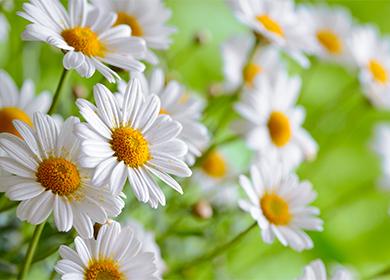The content of the article
The healing properties of chamomile pharmacy were first formulated by the ancient Greek physician Hippocrates in the fifth century BC. Until the fourteenth century, the plant remained the most sought after medicine. After this, a period of oblivion began, associated with the search for new forms of drugs. Interest in him woke up again in the nineteenth century. And in the twenty-first, it is recognized as the most studied and often used among medicinal herbs.
Whatever options for the name of this plant you come across, romashka is not an option. Latin gave this plant the name Matricāria chamomīlla. Its inflorescences contain highly active chemicals that can have anti-inflammatory, light analgesic, antiseptic effects on tissues and a general calming effect on the whole body, which makes it one of the most popular medicinal plants. And of course, we need to know not just the method of application, but what indications for its use, how to use it as a medicine at home, and which chamomile is medicinal?
Features of chamomile officinalis
Researchers associate the Latin name of the plant chamom? Lla with the terms chamai and melon. The first means "low", as the stems of the culture grow small. The second is the “apple”, since the inflorescences at the beginning of flowering resemble apples in appearance and aroma.
The term matric? Ria refers to the Latin word matrix or uterus. It was introduced by the Swiss botanist von Haller in the eighteenth century, probably because the plant was traditionally used in folk medicine for the treatment of gynecological diseases.
In Russia, culture acquired a name adapted from the Latin chamaemelon romana. It was believed that the plant was imported from Rome, called Romanov grass, a novel. Later it was transformed into the term "Roman chamomile", which is a synonym for pharmacy culture.
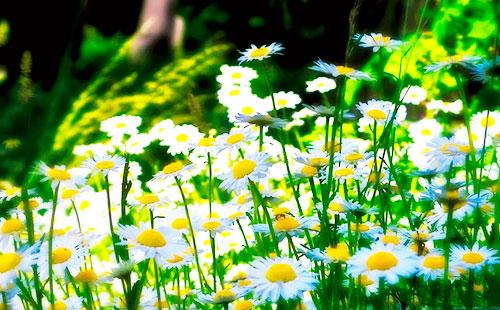
Description
The medicinal plant chamomile is well recognized. This is an annual grass with a thin, strong root, located shallow in the soil. A thin, rounded, absolutely straight and undescended stalk departs from the root, from which lateral shoots develop. Stem height is forty-sixty centimeters.
On it there are regular sedentary leaves, cut into thin, narrow segments. They are light green, often resembling elastic threads.
The flowering period occurs at different times, which depends on the climatic zone and weather conditions. In warm areas and with the early onset of summer, chamomile blooms in May, and by mid-July it fades completely. If the weather is cool, flowering can be delayed until July-August and continue until the first frost. The plant does not bloom at the same time, even the nearby bushes bloom one after another, gradually.Therefore, the chamomile field or plantation is covered with elegant white flowers throughout the entire warm period.
Plant flowers do not exceed twenty five millimeters in diameter. They are complex, with a white outer part and a yellow inner one. White petals look like tongues. At the beginning of flowering, look up, then fall horizontally. When blooming, the daisy “hangs” the white petals down.
In the central part, the flowers are intensely yellow, sunny, but so small that they are usually perceived as a holistic center. They open later than the outer leaves, therefore, in the first flowering period, the core of the flowers seems concave, then becomes even, and when the white tongues fall down, the central part acquires a volume, looks convex, conical.
Field chamomile propagates exclusively by seeds. The plant brings a "crop" by August. On one bush, up to five hundred seeds are formed, so the culture is considered extremely prolific. The distribution of seeds is facilitated by environmental conditions: wind, animals, and even humans.
They are so light that they spread efficiently over long distances, allowing the culture to populate new areas. But once in the ground, they do not always emerge, as they are quite demanding on the temperature and humidity of the soil. And they can’t stand the shady areas where the daisy almost never emerges.
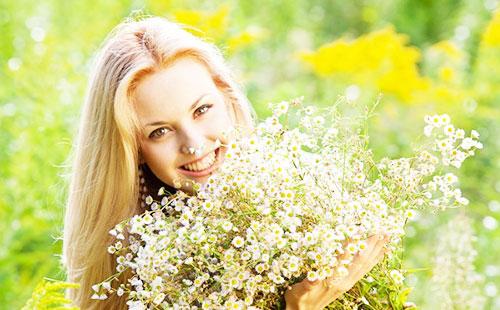
Geography and distribution
Accurate data where the plant comes from does not exist. It is believed that it came to Russia from North America. In the nineteenth century, its first organized planting was defeated in the St. Petersburg Botanical Garden. Almost simultaneously, areas of distribution of wild cultures arose in the Far East, where they were probably brought in by ships.
The culture spreads easily and freely, as its seeds are very light. In just a few decades, she “conquered” the European part of Russia and set off further, to the north and south. It grows everywhere, especially prefers sunny areas and cultivated agricultural areas. Therefore, it is found on cultivated lands - between fields, in or near vegetable gardens, in meadows, in gardens and parks.
It adapts well to various types of soils, so plant colonies can be observed in not the most favorable places, for example, on the sidelines of roads and railways. In cities, it grows like a weed in landscaped areas, lawns.
Since the healing properties of chamomile are recognized as modern medicine, it is grown in specialized farms. They are located in the Far East, in the suburbs, in the southern regions.
Self-cultivation of a plant in a personal plot is also possible. Seeds are scattered on compacted, fertilized soil, preventing their seeding. Suitable time for sowing is mid-autumn, before frost. The first shoots with abundant watering and access to the sun are formed within ten to twenty days. By spring, the rosette that has formed has gone into active growth and flowering is observed in the early stages. The full cycle of annual grass development takes four months.
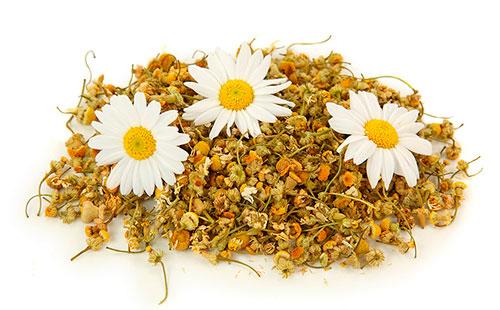
Collection and Harvesting
The main medicinal value is the flowers of the plant. They are used as part of herbal preparations, preparation of infusions for internal use and external treatments. Chamomile root is not collected.
To collect chamomile pharmacy, the initial flowering period is chosen, when the white petals-tongues look up or are located horizontally. If you skip this period, the raw materials will be of poor quality: during the drying process, a lot of garbage will form in it.It is important to collect in good, sunny weather, avoiding wetting of the raw materials.
Collect flower baskets, cutting them off from peduncles. When collecting, long legs are captured, which should be removed before drying. On each square meter of crops, it is important to leave three to five flowers intact so as not to exterminate the chamomile population.
Freshly picked chamomile flowers are poured into baskets and transported to the place of drying. They are laid out under a canopy, sprinkling on a cement or wooden base with a thin layer. In order for the inflorescences to dry out well, each square meter should not have more than a kilogram of raw materials. Periodically harvested material is ted with hands or a rake.
When drying in electric dryers, the temperature is set to forty degrees. Check the availability of raw materials in the same way.
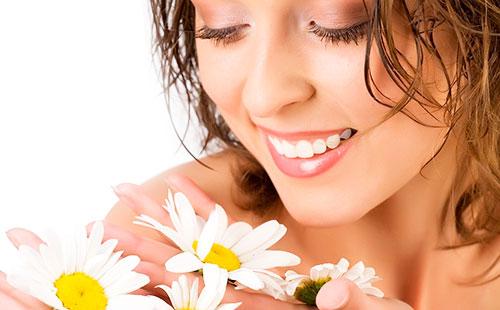
Composition and properties
The composition of medicinal raw materials includes essential oil. Its volume does not exceed one and a half percent. The oil is saturated in blue, which is associated with the presence in it of up to fifteen percent of chamazulene. About half of the volume of active substances in the oil is sesquiterpenes, a small part is occupied by a-bisabolol. Dried raw materials contain flavanoid glycosides and apigenin in the amount of not more than eight percent.
Carotene, bitterness and mucus, organic acids of no practical value are also highlighted. The main active ingredient, which determines the beneficial properties of chamomile, is recognized as chamazulen in combination with a-bisabolol.
In recent years, the question of how useful chamomile has been studied by science. A number of experiments were carried out using its various dosage forms: liquid extract, tincture, decoction of dried flowers. The following types of exposure to medicinal raw materials were identified.
- Antiseptic, anti-inflammatory activity. Water-alcohol forms of a medicinal plant suppress the growth and vital activity of pathogenic microorganisms: staphylococcus, several varieties of streptococcus (salivary, mutans and group B). Active against cabbage sticks and bacteria that cause leptospirosis. Essential oil actively inhibits the development of hay bacillus and Staphylococcus aureus. Inhibition of the inflammatory process indicators - prostaglandins and leukotrienes - has been experimentally confirmed inhibition by aqueous dosage forms of chamomile.
- Antispasmodic effect. It is provided by terpene compounds. Their selection occurs only during the heating of the raw materials, so the water infusion of chamomile is many times more effective than dry powder taken orally.
Studies of the internal and external use of the drug. Anti-inflammatory activity during internal use was established during the treatment of rats and guinea pigs. With intradermal, intraperitoneal administration of chamomile infusion, a pronounced anti-inflammatory effect was observed with fever, erythema. Some depression of the central nervous system was also found: in animals, motor and search activity decreased, and the duration of sleep increased.
With external use, the medicinal properties of chamomile are manifested in a decrease in skin inflammation, stimulation of tissue regeneration. Tests were conducted on patients after removal of skin areas, with weeping, poorly healing wounds, with the initial stage of the inflammatory process.
The extract was applied as a cream to the affected areas. Chamomile treatment markedly reduced the inflammatory process, and in terms of effectiveness exceeded the effect of hydrocortisone ointment with an active substance concentration of 0.25%.
In another study in the treatment of erythema of the hands and feet, the effectiveness of a cream with chamomile extract was compared with the action of hydrocortisone, bufexamak, fluocortin butyl ether, a traditional corticosteroid. The effectiveness of chamomile treatment was not inferior to drugs.
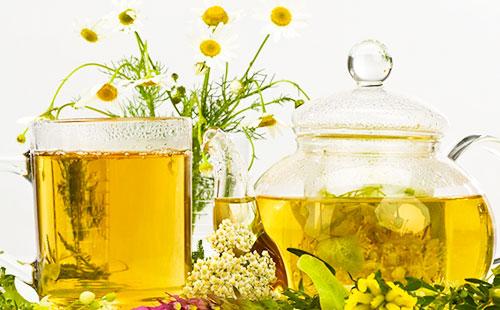
The use of chamomile pharmacy
Instructions for use of chamomile pharmacy contains a range of therapeutic options. It is recommended to use it in case of violations of the gastrointestinal tract, febrile conditions, inside and out as an anti-inflammatory agent.
Infusion for abdominal pain
For diseases of the gastrointestinal tract, it is recommended to take water infusion of chamomile inside. The use of chamomile broth, for the preparation of which the flowers need to be boiled, has no practical meaning. The main active component of chamazulen is destroyed during boiling. Raw materials should be poured with hot water and insisted for several hours.
Cooking
- Place two tablespoons of inflorescences in a container.
- Pour boiling water with a volume of 200 ml.
- Cover, leave to brew for two hours.
Take a medicinal infusion three to four times a day on an empty stomach in a tablespoon. It has a disinfecting effect, reduces gas formation, inhibits the inflammatory process. It is useful for the stomach, as it has an antispasmodic, enveloping effect, helps with gastritis, in the treatment of peptic ulcers, and has a slight choleretic effect.
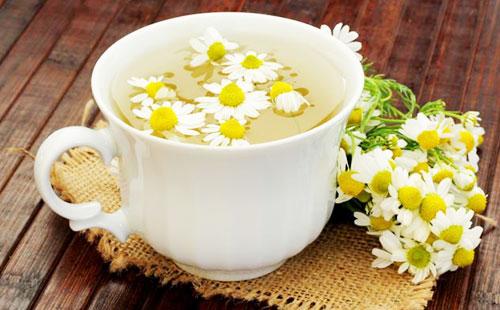
Chamomile tea
The beneficial properties of chamomile tea are well known, so they drink it instead of ordinary tea, often choosing filter bags for ease of use. Such tea with chamomile will not bring any benefit, since it contains low-quality, ground raw materials. To make the drink both healthy and tasty, you should choose raw materials in the form of whole flower baskets for its preparation and brew it correctly.
How to drink chamomile so that the plant benefits? Flowers cannot be boiled, but it does not make sense to drink tea fifteen minutes after brewing. Hamazulen dissolves extremely slowly in water, so the following tea preparation technique is recommended.
Cooking
- Pour in a thermos dried, slightly crushed flowers at the rate of a teaspoon per 200 ml of water.
- Pour boiling water and tightly cork.
- Leave to infuse for 2-3 hours, occasionally shaking the thermos.
- Drink it warm.
What is the benefit of chamomile tea made using this technology? It normalizes the disturbed functions of the gastrointestinal tract. Its anti-inflammatory activity is manifested in diseases of the kidneys, with prostatitis. With cystitis, baths with chamomile will be less effective than a drink taken orally. Its light enveloping properties will help with cough, with inflammation of the upper respiratory tract.
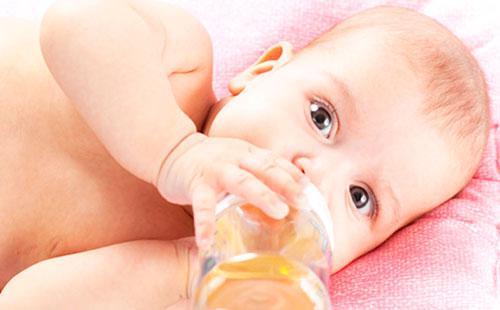
Infusion for babies
The World Health Organization does not recommend the use of chamomile in children under three years of age. But in domestic pediatrics, chamomile broth for infants is recognized as a safe and effective remedy for colic, bloating in the abdomen, intestinal cramps.
It helps the escape of gases and has a mild sedative effect. Moreover, according to the author of the book on medicinal plants V.I. Popova, significantly more effective when used for children compared with dill water, other means.
Cooking
- Pour a teaspoon of dried flowers into a thermos.
- Pour boiling water with a volume of two hundred milliliters.
- Close tightly, leave to brew for two hours, shake periodically.
Take infusion of chamomile for newborns should be in half - one teaspoon half an hour before bedtime. It is useful for irritability, reduces the severity of gum discomfort and soreness when teething.
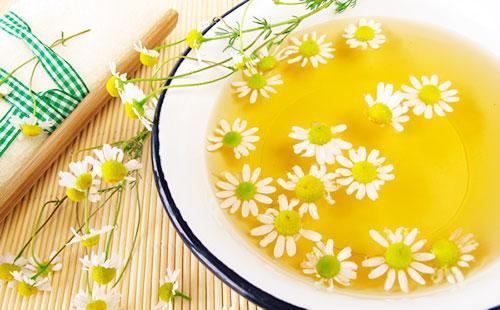
Infusion for rinsing, compresses
It is recommended to use the infusion for the treatment of poorly healing, wetting wounds. Effective for gums with gingivitis, periodontal disease, tonsillitis.It is used to treat thrush in the mouth, on the chest, in gynecological practice for washing, douching. Lotions are used for conjunctivitis, hemorrhoidal fissures with concomitant inflammation.
Cooking
- Pour 50 grams of flowers (four full tablespoons) into a thermos.
- Pour boiling water with a volume of one liter.
- Leave to infuse for two hours, shake periodically.
For rinsing, the infusion is used in its pure form. For lotions, apply it on a cotton cloth, apply to affected areas for 15-20 minutes.
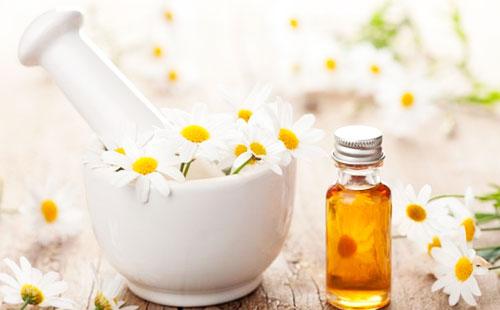
Infusion for baths
Sedentary baths of chamomile are recommended in gynecological practice for the treatment of infectious and inflammatory diseases of the vagina, genitals. Used in treatment thrush, colpitis of a bacterial nature, inflammation of the tissues of the labia due to cystitis. Recommended in childhood to reduce skin inflammation with sweating, atopic dermatitis.
Cooking
- Pour dry flowers into a thermos at the rate of five grams of raw materials (teaspoon) for each liter of water.
- Pour a liter of boiling water.
- Leave to infuse for two hours, shake periodically.
- Pour the baths into warm water, mix.
Take baths until symptoms are less severe. According to reviews, they do not dry the skin, so they can be used to treat delicate places and skin of babies.
The same infusion is used for hair to give it strength and a golden hue. Rinse their hair after washing and applying the balm two to three times a week.
Contraindications
For external use, chamomile has no contraindications. It can be used from infancy to treat skin diseases. During pregnancy, douching with infusion is allowed. Ingestion does not cause a negative effect on the child, but there is evidence of an abortive effect of chamomile infusion.
The main contraindication to taking the drug inside is individual intolerance.
Chamomile is a widespread and affordable plant. You can harvest it yourself or buy dried raw materials in a pharmacy. It has a pronounced anti-inflammatory effect, when used on the skin is not inferior to the traditional corticosteroid drug hydrocortisone. When taken orally, it reduces inflammation, cramping, and normalizes the functioning of the gastrointestinal tract. It can be used for infants.
